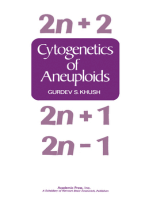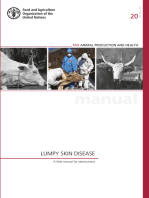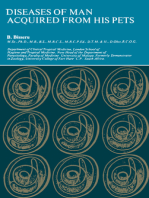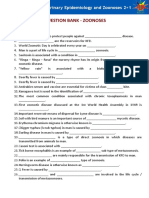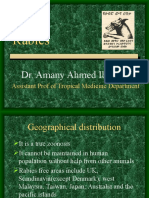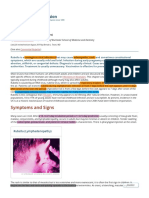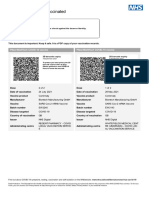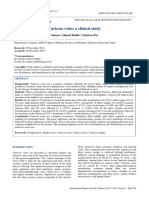Professional Documents
Culture Documents
Erysipeloid
Uploaded by
oren_soCopyright
Available Formats
Share this document
Did you find this document useful?
Is this content inappropriate?
Report this DocumentCopyright:
Available Formats
Erysipeloid
Uploaded by
oren_soCopyright:
Available Formats
http://www.ncbi.nlm.nih.gov/pubmed/22957967 http://www.dermis.net/dermisroot/en/10747/diagnose.htm http://emedicine.medscape.
com/article/1054170-overview
Definition and Etiology Erysipeloid (Rosenbach erysipeloid) is an acute bacterial infection of traumatized skin and other organs. Erysipeloid is caused by the microorganism Erysipelothrix rhusiopathiae (insidiosa), which long has been known to cause animal and human infections. Direct contact between meat and traumatized human skin results in erysipeloid especially,commercial fishing (fishmongers). Other more-generalized forms of infection with this organism also exist, including a septic form usually associated with endocarditis. Many infections may be self-limited. They have rarely been reported in children or in immunocompromised patients. This microbe is sensitive to many mainstream antibiotic agents.The infection is more likely to occur during the summer or early fall. Diagnosis
Erysipeloid may present in humans as one of 3 clinical forms. 1.Localized form of erysipeloid Lesions most commonly affect the hands, mainly the webs of the fingers; however, any exposed area of the body may be affected. Lesions consist of well-demarcated, bright red-to-purple plaques with a smooth, shiny surface. Lesions are warm and tender. They leave a brownish discoloration on the skin when resolving. Sometimes vesicles may be present
2.Diffuse cutaneous form of erysipeloid Multiple lesions appear on various parts of the body. Lesions are well-demarcated, violaceous plaques with an advancing border and central clearing. 3.Systemic form of erysipeloid Skin lesions may not be apparent. If present, skin lesions appear as localized areas of swelling surrounding a necrotic center. Skin lesions also may present as several follicular, erythematous papules. Endocarditis is the most common, but still rare, manifestation of systemic erysipeloid.[7] In the first 2 forms of erysipeloid, patients present with local burning or pain at lesion sites. They may or not have fever, malaise, and other constitutional symptoms. In the generalized form, patients present with fever, chills, weight loss, and a variety of other symptoms (eg, joint pain, cough, headache), depending on the organ system involved. Differential diagnosis - Cellulitis - Erysipelas Treatment -Medical Care The antibiotics of choice for the 3 forms of erysipeloid is penicillin or cephalosporin.Ceftriaxone proved to have an effect against Erysipelothrix rhusiopathiae. In patients who are allergic to penicillin, ciprofloxacin alone or erythromycin in combination with rifampin may be used. The microorganism is resistant to vancomycin, an important consideration in patients with endocarditis caused by E rhusiopathiae.
E rhusiopathiae has been shown to be eradicated from surfaces by the use of simple home disinfectants; thus, an important step in the prevention of infection may be to spray hazardous work areas (eg, fishing boats, meat counters) with disinfectants. -Surgical Care Procedures usually are not used in the cutaneous form of erysipeloid. Even a simple incision and drainage of lesions is not recommended as this may prolong the recovery time. Individuals with the systemic form of erysipeloid may undergo surgery (eg, cardiac valve replacement), pleural tap, or other procedures, depending on extent of organ involvement.
You might also like
- The Leukotrienes: Chemistry and BiologyFrom EverandThe Leukotrienes: Chemistry and BiologyLawrence ChakrinNo ratings yet
- Immunomodulation in Domestic Food Animals: Advances in Veterinary Science and Comparative MedicineFrom EverandImmunomodulation in Domestic Food Animals: Advances in Veterinary Science and Comparative MedicineBernald CharleyNo ratings yet
- Extrachromosomal DNAFrom EverandExtrachromosomal DNADonald CummingsNo ratings yet
- Behavioral and Department ModelsFrom EverandBehavioral and Department ModelsBert ZuckermanNo ratings yet
- Rinderpest and Peste des Petits Ruminants: Virus Plagues of Large and Small RuminantsFrom EverandRinderpest and Peste des Petits Ruminants: Virus Plagues of Large and Small RuminantsNo ratings yet
- Overview Q FeverDocument8 pagesOverview Q FeverAliyyahNo ratings yet
- #Spirochaetes & Mycoplasma#Document28 pages#Spirochaetes & Mycoplasma#Sarah PavuNo ratings yet
- Parasites of Cattle and Sheep: A Practical Guide to their Biology and ControlFrom EverandParasites of Cattle and Sheep: A Practical Guide to their Biology and ControlNo ratings yet
- Feline Infectious PeritonitisDocument59 pagesFeline Infectious PeritonitisBeda Meda100% (1)
- The Mycoplasmas V1: Cell BiologyFrom EverandThe Mycoplasmas V1: Cell BiologyM. F. BarileNo ratings yet
- Lumpy Skin Disease: A Field Manual for VeterinariansFrom EverandLumpy Skin Disease: A Field Manual for VeterinariansNo ratings yet
- Novel Vaccine Approaches (Yiming Shao)Document29 pagesNovel Vaccine Approaches (Yiming Shao)National Press Foundation100% (1)
- VMD-422 Questions - (II)Document8 pagesVMD-422 Questions - (II)ਰੋਹਿਤ ਬਾਵਾNo ratings yet
- Reproductive Technologies in AnimalsFrom EverandReproductive Technologies in AnimalsGiorgio PresicceNo ratings yet
- Veterinary Basics1Document119 pagesVeterinary Basics1Saleem Ahmed Shahwani0% (1)
- The Art and Science of Thread Lifting: Based on Pinch AnatomyFrom EverandThe Art and Science of Thread Lifting: Based on Pinch AnatomyNo ratings yet
- Standardised Nomenclature of Animal Parasitic Diseases (Snopad)Document67 pagesStandardised Nomenclature of Animal Parasitic Diseases (Snopad)Pwaveno BamaiyiNo ratings yet
- VirologyDocument200 pagesVirologyVishal Singh GaharwarNo ratings yet
- Practical Transfusion Medicine for the Small Animal PractitionerFrom EverandPractical Transfusion Medicine for the Small Animal PractitionerNo ratings yet
- Pathogenesis, Treatment and Prevention of LeishmaniasisFrom EverandPathogenesis, Treatment and Prevention of LeishmaniasisMukesh SamantNo ratings yet
- Recent Advances in Acarology: Volume IIFrom EverandRecent Advances in Acarology: Volume IIJ. G. RodriguezRating: 5 out of 5 stars5/5 (1)
- Multifaceted Role of IL-1 in Cancer and InflammationFrom EverandMultifaceted Role of IL-1 in Cancer and InflammationManisha SinghRating: 5 out of 5 stars5/5 (1)
- Pre Pubertal Gonadectomy in Dogs and Cats-Part IIIDocument5 pagesPre Pubertal Gonadectomy in Dogs and Cats-Part IIItaner_soysurenNo ratings yet
- General Veterinary MicrobiologyDocument73 pagesGeneral Veterinary MicrobiologySanjay KumarNo ratings yet
- Pyrantel Parasiticide Therapy in Humans and Domestic AnimalsFrom EverandPyrantel Parasiticide Therapy in Humans and Domestic AnimalsNo ratings yet
- iPSCs for Studying Infectious DiseasesFrom EverandiPSCs for Studying Infectious DiseasesAlexander BirbrairRating: 5 out of 5 stars5/5 (1)
- Sheep Breeding: Studies in the Agricultural and Food SciencesFrom EverandSheep Breeding: Studies in the Agricultural and Food SciencesG.L TomesNo ratings yet
- Vpe 321 ZooDocument23 pagesVpe 321 ZooransinghNo ratings yet
- Epidemiology and ZoonosesDocument149 pagesEpidemiology and ZoonosesAbhijith SP100% (1)
- Genetics of Reproduction in SheepFrom EverandGenetics of Reproduction in SheepR.B. LandNo ratings yet
- Reproduction in Domestic AnimalsFrom EverandReproduction in Domestic AnimalsH. H. ColeNo ratings yet
- CLONORCHISDocument23 pagesCLONORCHISodysseyfairy2739No ratings yet
- Malaria: Immunology and ImmunizationFrom EverandMalaria: Immunology and ImmunizationJulius P. KreierNo ratings yet
- Immunology Book-Maruthuram CorrectionDocument84 pagesImmunology Book-Maruthuram CorrectionK.VISHNUVARDHAN100% (1)
- Veterinary PathologyDocument5 pagesVeterinary PathologyDrRakesh Raki100% (1)
- Rabies: Dr. Amany Ahmed IbrahimDocument31 pagesRabies: Dr. Amany Ahmed IbrahimMohammed Abd ElfattahNo ratings yet
- 1 Microbiology Course ContentDocument16 pages1 Microbiology Course ContentAziz AnisahNo ratings yet
- Scrub Typhus: The Re-Emerging Threat - Thesis SynopsisDocument17 pagesScrub Typhus: The Re-Emerging Threat - Thesis SynopsisRajesh PadhiNo ratings yet
- Thesis On Honeybee HealthDocument104 pagesThesis On Honeybee Healthamsalu aregaNo ratings yet
- Insect Reproduction CK Dash SAUDocument3 pagesInsect Reproduction CK Dash SAUChandra Kanta Dash100% (1)
- Snake Bites: and Their TreatmentDocument15 pagesSnake Bites: and Their TreatmentRamakrishna JakkulaNo ratings yet
- Genetics Lab ReportDocument7 pagesGenetics Lab ReportChristinaLees0% (1)
- Illustrated Manual of Infectious Diseases of Livestock in AfghanistanDocument245 pagesIllustrated Manual of Infectious Diseases of Livestock in Afghanistanqadir-qadis100% (2)
- Trichuriasis: Disease Type: Parasitic Disease Common Name: Causative Agent: Species of Trichuris Disease DiscriptionDocument9 pagesTrichuriasis: Disease Type: Parasitic Disease Common Name: Causative Agent: Species of Trichuris Disease DiscriptionBrijesh Singh YadavNo ratings yet
- Rubella - Pediatrics - MSD Manual Professional EditionDocument4 pagesRubella - Pediatrics - MSD Manual Professional EditionSadia Shafique100% (1)
- Alsangedy Bullets For Paces Churg-Strauss SyndromeDocument2 pagesAlsangedy Bullets For Paces Churg-Strauss SyndromeGhulamMemonNo ratings yet
- The Decompressive CraniectomyDocument32 pagesThe Decompressive CraniectomyAmerican English CourseNo ratings yet
- PAFP Consensus Guidelines On Community-Oriented Care During A COVID-19 EpidemicDocument16 pagesPAFP Consensus Guidelines On Community-Oriented Care During A COVID-19 EpidemicDan Paul AmiscuaNo ratings yet
- Chromosome 19Document12 pagesChromosome 19Neil Justin BermoyNo ratings yet
- Beforeand After Study Designs BMJ2014349 G 5074Document3 pagesBeforeand After Study Designs BMJ2014349 G 5074megabuana keuNo ratings yet
- Peptic Ulcer HDocument6 pagesPeptic Ulcer HIlyes FerenczNo ratings yet
- IDBDocument2 pagesIDByondaime15No ratings yet
- Avian FluDocument4 pagesAvian Fluapi-359754195No ratings yet
- High Risk Red Eye (Go)Document96 pagesHigh Risk Red Eye (Go)ณัช เกษมNo ratings yet
- Cholera: Breaking It's Chain of InfectionDocument19 pagesCholera: Breaking It's Chain of Infectionjamal janNo ratings yet
- Adhikari 2018Document7 pagesAdhikari 2018Ilham HidayatNo ratings yet
- Pathophysiology of CVD InfarctDocument2 pagesPathophysiology of CVD InfarctIris Caberte86% (7)
- PLOTKINDocument6 pagesPLOTKINElPaisUyNo ratings yet
- C Ovid 19 Positive Test Report FormDocument2 pagesC Ovid 19 Positive Test Report FormSai Phaneendra KumarNo ratings yet
- Michael W, COMAT SurgeryDocument14 pagesMichael W, COMAT SurgerySeanNo ratings yet
- Infective EndocarditisDocument10 pagesInfective EndocarditisShrests SinhaNo ratings yet
- Balantidium ColiDocument10 pagesBalantidium ColisuqylNo ratings yet
- REMEDY REACTION - Dr. Amritha MohanDocument25 pagesREMEDY REACTION - Dr. Amritha Mohanmanish baghelNo ratings yet
- ACPGBI CRC Part 1Document3 pagesACPGBI CRC Part 1NevilleNo ratings yet
- Active and Passive ImmunityDocument13 pagesActive and Passive Immunitysha_man029No ratings yet
- Spinal Cord Disease by GadisaDocument128 pagesSpinal Cord Disease by GadisaGadisa DejeneNo ratings yet
- Nhs Covid Pass - Vaccinated: Pfizer/Biontech Covid-19 Vaccine Pfizer/Biontech Covid-19 VaccineDocument1 pageNhs Covid Pass - Vaccinated: Pfizer/Biontech Covid-19 Vaccine Pfizer/Biontech Covid-19 VaccineVadim TuscariNo ratings yet
- ΕΜΠΥΡΕΤΟ EKPADocument25 pagesΕΜΠΥΡΕΤΟ EKPAElenaNo ratings yet
- TB MDR Ruth Putri-1510015071Document16 pagesTB MDR Ruth Putri-1510015071Elizabeth SagalaNo ratings yet
- Lumpy Skin DiseaseDocument28 pagesLumpy Skin DiseaseShivaputraNo ratings yet
- Varicose Veins: A Clinical Study: Original Research ArticleDocument5 pagesVaricose Veins: A Clinical Study: Original Research ArticleAndhika DNo ratings yet
- Hepato Splenomegaly: IAP UG Teaching Slides 2015-16Document20 pagesHepato Splenomegaly: IAP UG Teaching Slides 2015-16AnchalNo ratings yet
- Pneumonia in Children - Epidemiology, Pathogenesis, and Etiology - UpToDateDocument29 pagesPneumonia in Children - Epidemiology, Pathogenesis, and Etiology - UpToDatejess.khoo.1204No ratings yet
- American J Hematol - 2022 - Ansell - Hodgkin Lymphoma 2023 Update On Diagnosis Risk Stratification and ManagementDocument11 pagesAmerican J Hematol - 2022 - Ansell - Hodgkin Lymphoma 2023 Update On Diagnosis Risk Stratification and ManagementparralespovedaNo ratings yet
- Correction of Measurement Error - Part 1Document22 pagesCorrection of Measurement Error - Part 1Varun KumarNo ratings yet





